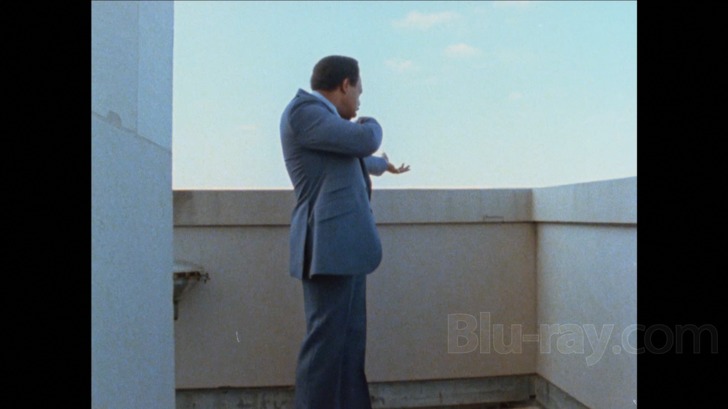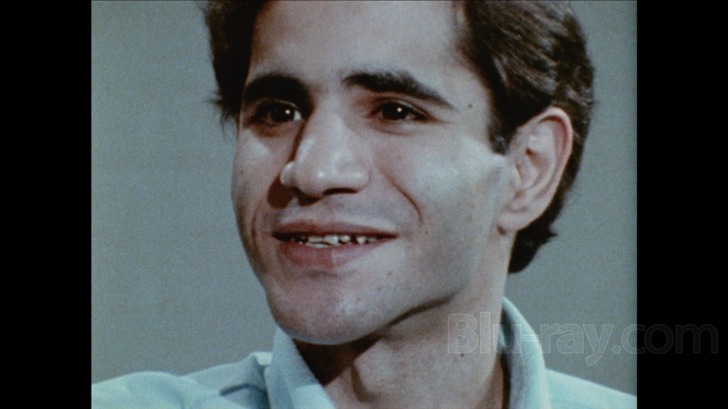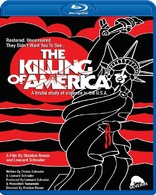The Killing of America Blu-ray Movie
HomeThe Killing of America Blu-ray Movie 
Severin Films | 1981 | 1 Movie, 2 Cuts | 90 min | Not rated | Oct 25, 2016Movie rating
6.9 | / 10 |
Blu-ray rating
| Users | 0.0 | |
| Reviewer | 3.0 | |
| Overall | 3.0 |
Overview
The Killing of America (1981)
A documentary of the decline of America. It features a lot a great footage (most exclusive to this film) from race riots to serial killers and much-much more.
Starring: Ed Dorris, Thomas Noguchi, Sirhan Sirhan, Wayne Henley, Ed KemperNarrator: Chuck Riley
Director: Sheldon Renan, Leonard Schrader
| Documentary | 100% |
Specifications
Video
Video codec: MPEG-4 AVC
Video resolution: 1080p
Aspect ratio: 1.33:1
Original aspect ratio: 1.37:1
Audio
English: LPCM 2.0 (48kHz, 16-bit)
Japanese: LPCM 2.0 (48kHz, 16-bit)
Subtitles
English, English SDH
Discs
Blu-ray Disc
Single disc (1 BD)
Playback
Region A (B, C untested)
Review
Rating summary
| Movie | 2.5 | |
| Video | 3.5 | |
| Audio | 4.0 | |
| Extras | 4.0 | |
| Overall | 3.0 |
The Killing of America Blu-ray Movie Review
Reviewed by Jeffrey Kauffman November 16, 2016America’s so-called “gun culture” tends to get a pretty intense public airing during election season, not to mention every time another mass shooting takes place, but for those of us who have been around awhile, the only mantra that seems to emerge from such discussions is “the more things change, the more things remain the same.” There’s a rather salient example of that maxim in The Killing of America, a supposedly notorious documentary that appeared in the “Dark Ages” of 1982. Made in the wake of the assassination attempt on President Reagan (an event which is one of many vignettes included in the film), but before the horrors of Columbine and too many other sad incidents to enumerate, The Killing of America seems almost—almost—quaint at times, as it details everything from the assassination of President Kennedy to the first mass shooting which was also a mass media “event”, that by the Texas Tower Sniper Charles Whitman, to the Manson Family murders, to the Jonestown Massacre, to several other “lesser” moments that didn’t really penetrate into American consciousness, perhaps because there were always other, more staggering, murder sprees to attract attention. The Killing of America is probably unavoidably a “success” as a litany of such tragedies that have been visited on the nation, but as a political or even moral statement, it falls weirdly short, never really managing to confront the central issue the underlies these horrifying events—namely, why do they happen with such alarming frequency in the United States?

The American version of the film (there’s also an extended Japanese version, which will be mentioned below) begins with some startling but frankly kind of oddly uninvolving footage of police shooting a black man to death on a city street. The fact that footage of this sort can be termed “uninvolving” is perhaps the best example of how desensitized many of us have become to such news stories over the past several decades. There are a number of other such moments memorialized in The Killing of America, while Chuck Riley’s sonorous narration gives background information while also occasionally offering brief data points as to how many guns were in America at the time of the documentary’s making (I’m sure the numbers have only increased exponentially in the intervening decades).
The two events involving American presidents are perhaps among the better known crimes The Killing of America details, albeit without much actual “detail”. Interestingly, evidently director Sheldon Renan (who also provides an interesting commentary for the American version) was able to lease the original Zapruder film from the Zapruder family and was probably the first to “stabilize” the footage to remove the shakiness that Mr. Zapruder’s shock at filming the event introduced to the footage. (Such “stabilized” video offerings are all over the internet now, especially on such sites as YouTube.) There’s really no overly revelatory information imparted in this segment, other than the fact that the Warren Commission decided there was a sole assassin while the later Congressional hearings came to the conclusion that there were two shooters.
The Reagan footage is probably even more cursory, though there’s some interesting slow motion information offered that clearly shows John Hinckley, Jr.’s gun at the right of the frame pointed squarely at several people. Some of the most disturbing imagery in this sequence is actually of Reagan’s press secretary lying prone on the sidewalk with a lot of blood spewing from his head. Brady of course would give his name to the Brady Bill, something that’s still hotly debated, and Brady of course would carry the scars of this shooting for the rest of his life.
Speaking of disturbing imagery, while there are extended shots of the aftermath of the Jonestown Massacre, not to mention a plethora of other deaths that were captured by news crews, probably the most squirm worthy moments are some in the Los Angeles coroner’s labs, where a whole bunch of dead bodies lie on tables, some of them bearing absolutely gruesome wounds, and some of which have already undergone autopsies, meaning that (in at least one instance) their chests have been opened, revealing bloody ribcages, with at least some internal organs having been removed. This footage, while shocking, also seems among the most overtly exploitative in the documentary. What exactly is the point of it? Equally disturbing in a more psychological way is a brief interview segment with Robert F. Kennedy's assassin, Sirhan Sirhan, who comes off as strangely sweet natured.
There are a couple of other things that keep The Killing of America from (ahem) hitting its target. The first is the seemingly random array of incidents which are cobbled together to make up the documentary. At one moment, we’re dealing (however briefly) with an epochal event like the assassination of President Kennedy, and the next moment features security camera footage of a convenience store clerk getting gunned down. It’s almost as if (and probably not even almost) the only reason for at least some of the footage in this piece is that it exists. But this brings up the second, probably more debilitating, aspect of the documentary. While there are some allusions to the history of gun culture in the United States, notably with some quick “Wild West” reenactments and scenes of a little boy at a shooting arcade, there’s never really any in depth analysis given as to how this came to be and what it means for modern society. Instead we’re merely presented with a litany of news footage that does admittedly make it abundantly clear society has at least in part lost its mind to senseless violence. Why that seems to be the case is never fully addressed in The Killing of America, therefore making a lot of the enterprise seem purely exploitative.
The Killing of America Blu-ray Movie, Video Quality 

The Killing of America is presented on Blu-ray courtesy of Severin Films with an AVC encoded 1080p transfer in 1.33:1. As is typically the case with documentaries cobbled together from such a wide array of source material, there are highly variable levels of everything from sharpness and clarity to grain structure to damage to some inherited artifacts due to video anomalies or smaller formats being blown up. That said, there's a suitably gritty and filmic look to virtually all of the footage here, with an understanding that at least some has also been sourced from old video elements. There's nothing here that's going to knock any videophile's socks off, but for those wanting an accurate accounting of how The Killing of America probably looked in its brief initial screening, this Blu-ray gets the job done just fine. I've included a few screenshots of the additional footage in the Japanese version in positions 16 through 18.
The Killing of America Blu-ray Movie, Audio Quality 

The Killing of America features LPCM 2.0 mono tracks in the relative languages for the English and Japanese versions. Sonically the film isn't much to write home about, with the archival sound elements suffering from the vagaries of age and live broadcast anomalies, but the narration sounding clear and full bodied (especially with Riley's memorable voice). The recurrent bursts of gunfire explode with a bit of energy, but the track is not especially full sounding in the lower frequencies.
The Killing of America Blu-ray Movie, Special Features and Extras 

- Japanese Version (1080p; 1:55:46) is a good deal longer if not necessarily any more insightful, and contains a number of frankly kind of odd additions, including shots of the Grand Canyon, sporting events like skiing and surfing, and a long homage to John Lennon. More on point (in terms of the film's thesis on violence) are sequences on serial murderers like John Wayne Gacy and Ted Bundy. In Japanese with optional English subtitles.
- Audio Commentary with Director Sheldon Renan is available on the English version of the film.
- The Madness is Real: An Interview with Sheldon Renan (1080p; 20:22) is a good in depth piece and actually at least provides some context for what some of the creative crew had in mind for the piece.
- Cutting the Killing: An Interview with Editor Lee Percy (1080p; 16:09) is a really fun piece and will be of special interest to fans of Roar.
- Interview with Mondo Movie Historian Nick Pinkerton (1080p; 14:48) gets into some of the "shockumentary" aspects of the piece.
- Killing of America Trailer (1080p; 1:52)
The Killing of America Blu-ray Movie, Overall Score and Recommendation 

This is one of those releases where the supplements outweigh the inherent "worth" of the main feature. The Killing of America may or may not have noble intentions, but one way or the other it comes off at least at times as pure exploitation material, something that tends to undercut any serious philosophizing tendencies (which are in short supply anyway). Even those who don't care one whit about content and simply want a "shockumentary" may be disappointed that the piece, while notorious in its day, actually comes off as somewhat tame, considering what we've been through (and seen in other docs) in the interim. That said, it's been a cult item for years and the supplemental material is very interesting and may appeal to a wider swath of the general public than the documentary itself will.
Similar titles
Similar titles you might also like

Lost Soul: The Doomed Journey of Richard Stanley's Island of Dr. Moreau
House of Pain Edition
2014

Red Eye 4K
2005

Curfew
1989

3 from Hell 4K
2019

The Purge: Election Year 4K
2016

78/52: Hitchcock's Shower Scene
2017

The Dungeonmaster
Ragewar
1984

Hitchhike to Hell
1977

The Last Horror Film
1982

The Sadist
Sweet Baby Charlie
1963

Bound to Vengeance
2014

Never Sleep Again: The Elm Street Legacy
2010

The Blackening
2023

Leatherface
2017

No One Lives
2012

Red State
2011

Fahrenheit 11/9
2018

I Am Not Your Negro
2016

Where to Invade Next
2015

Best of Enemies
2015
